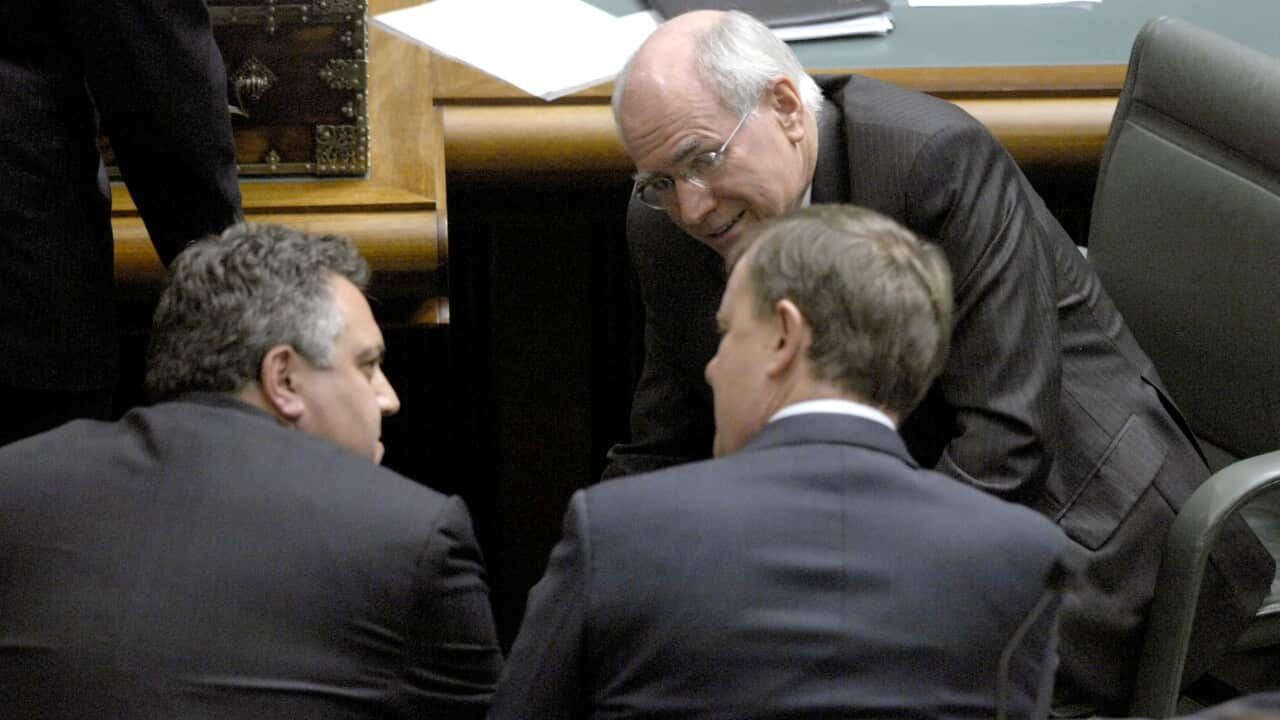In 2004, singer Shannon Noll topped the charts with What About Me, a ballad lamenting the unfairness of being overlooked and impatience with not getting one’s due.
The song also captured the sentiment of voters, who looked to then-prime minister John Howard and wildcard Opposition leader Mark Latham for policies to ease cost of living pressures as they headed to the polls later that year.
The issues facing Australians are laid bare in cabinet documents released by the National Archives of Australia (NAA) on Wednesday, and eerily similar to those critical in the upcoming 2025 election.
“The context then of cost of living was as pervasive as it is now, and although things have changed a lot, one thing hasn’t changed, and that is the dominance of cost of living as a pervasive political issue,” Howard said in December.
With 242 documents released, SBS News looked back at government decisions in 2004 that foreshadowed some of the major pressures heading into the next election.
Cabinet rules out changing capital gains to help first-home buyers
Housing affordability was a concern for the Howard government in 2004, with house prices steadily rising throughout the 1990s.
In 2003, the Productivity Commission was tasked with assessing conditions around first home ownership.
It proposed changes to the capital gains tax, which it found “added impetus during the recent boom” while acknowledging the rise was primarily due to “sustained economic growth”.
However, a submission from Howard and then-treasurer Peter Costello rejected the idea that changes to capital gains tax affected property values.
A graph showing how the average Australian property prices have increased over 20 years. Source: SBS News
“It is not clear that the change in capital gains taxation in 1999 would have had a large impact on house prices,” the submission said.
“While there is limited scope for government to improve affordability for first and other homebuyers in the short term, governments have an important role to play in facilitating efficient housing outcomes.”
Fearing further price swings and backlash ahead of the election, Howard and Costello shifted the onus back on the states and territories, pushing for the removal of stamp duty, among other things.
The Productivity Commission also backed this change, noting that the tax paid when transferring property ownership from one individual to another was “relatively inefficient”.
It concluded that stamp duty was an impediment to first-home buyers and discouraged people from downsizing, with the latter resulting in an inefficient use of existing housing stock.
Twenty years on, Housing Minister Clare O’Neil continues calls for states to axe stamp duty and replace it with a land tax.
According to ABS data, average weekly wages for Australian workers have doubled since 2004. Source: SBS News
However, states and territories have largely rejected the changes due to the large revenue stream. The ACT is the only jurisdiction to have slowly reduced stamp duty.
Historian David Lee explains that, while cabinet was aware that rising house prices “was a problem”, economic conditions are very different in 2025.
“I think the difference is, back in 2004, the economic indicators were pretty good,” he told SBS News.
“Low unemployment, inflation not very high, good resource prices for our exports. So, these are measures that any government would be comfortable with today.
“But house prices are even more of a problem now than they were then.”
Government rejects grocery conduct changes
The year 2024 began with then-Queensland premier Steven Miles using a watermelon to highlight the for their produce.
The social media post showed customers paying close to $10 at the checkout while farmers were paid $4. It displayed a price gouging issue that dominated headlines and led to an inquiry into supermarket giants Woolworths and Coles later in the year.
However, the 2004 cabinet papers reveal the government failed to address similar pressures at the checkout twenty years earlier.
The Buck Report on the retail grocery industry, presented to the government in January 2004, proposed a mandatory code for the sector underpinned by regulation.
It hoped to address issues of transparency, poor market information, clearer contracts, improve business practices and conflict resolutions, all of which were pervasive under a voluntary code governing the relationship between growers and grocers.
However, the proposed change to make the code mandatory was rejected by the government.
It instead committed to “industry self-regulation to address marketplace problems”, the papers reveal.
A graphic showing the prices of everyday goods including bread, petrol and milk in 2004. Source: SBS News
Howard government minister Joe Hockey wrote in a submission: “Mandating the code on the basis of anecdotal evidence risks exposing the government to criticism of unnecessary regulation and imposing associated compliance costs on an industry which is largely working well.”
“Despite the lack of evidence, there appears to be a genuine perception within parts of the industry … that growers are being mistreated.”
Twenty years on, the effects of the voluntary code have devastated farmers, with 30 per cent of vegetable and fruit growers considering leaving the industry last year, according to a study by peak horticulture industry body, AusVeg.
In conjunction with the 2024 review, the Greens pushed for the criminalisation of arbitrary price increases, a crackdown on , and a further examination of practices by Coles and Woolworths.
The party has also introduced legislation that would give the Australian Competition and Consumer Commission the power to force supermarket giants to sell parts of their business if they were found to have abused their market power.
The government has not signalled any support of this proposal but, following scrutiny and in response to feedback, the Food and Grocery Code of Conduct will become mandatory on 25 April.
It includes penalties of up to $10 million for grocery retailers or wholesalers, but the impact on supply chains and consumers will not be immediate.
— With additional reporting by the Australian Associated Press.



